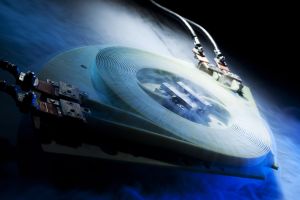For the first time, a superconducting current limiter based on YBCO strip conductors has now been installed at a power plant. At the Boxberg power plant of Vattenfall, the current limiter protects the grid for own consumption that is designed for 12 000 volts and 800 amperes against damage due to short circuits and voltage peaks. The new technology co-developed by Karlsruhe Institute of Technology and made by Nexans SuperConductors enhances the intrinsic safety of the grid and may help reduce the investment costs of plants.
“For a long time, high-temperature superconductors were considered to be difficult to handle, too brittle, and too expensive for general industrial applications,” explains project manager Wilfried Goldacker from Karlsruhe Institute of Technology. “The second generation of high-temperature superconductor wires based on YBCO ceramics is much more robust. Properties have been improved.” Superconducting current limiters work reversibly. In case of current peaks after short circuits in the grid, no components are destroyed. The limiter automatically returns to the normal state of operation after a few seconds only. Consequently, the power failure is much shorter than in case of conventional current limiters, such as household fuses, whose components are destroyed and have to be replaced with a high time and cost expenditure.
“Superconducting current limiters have a number of advantages for the stability of medium- and high-voltage grids,” explains Mathias Noe, Head of the Institute of Technical Physics of Karlsruhe Institute of Technology. Reliable, compact current limiters enhance the operation stability of power grids and allow for a simplification of the grid structure. As they are protected against current peaks, decentralized energy generators, such as wind and solar systems, can be integrated much better in grids. Expensive components in the existing grid are protected efficiently, components in future grids can be designed for smaller peak currents, and transformers will no longer be necessary. Investment costs of power plants and grids will be reduced. Moreover, superconducting current limiters on the basis of YBCO can also be applied in high-voltage grids of more than 100 kilovolts for better protection against power failures in the future.
YBCO stands for the constituents of the superconductor: Yttrium, barium, copper, and oxygen. An YBCO crystal layer of about 1 micrometer in thickness is grown directly on a stainless steel strip of a few millimeters in width that gives the ceramics the necessary stability. Below a temperature of 90° Kelvin or minus 183° Celsius, the material becomes superconductive. However, superconductivity collapses abruptly when the current in the conductor exceeds the design limits. This effect is used by the current limiter. In case of current peaks in the grid, the superconductor loses its conductivity within fractions of a second and the current will flow through the stainless steel strip only, which has a much higher resistance and, thus, limits the current. The heat arising is removed by the cooling system of the superconductor. A few seconds after the short circuit, it is returned to normal operation in the superconducting state. YBCO superconducting layers on stainless steel strips are more stable and operation-friendly than first-generation superconductors based on BSCCO ceramics. Moreover, their production does not require any noble metals, such as silver, and will presumably be cheaper.
The superconducting current limiter was developed in the past two years under the ENSYSTROB project. The project partners are Karlsruhe Institute of Technology, Nexans SuperConductors, TU Dortmund, and BTU Cottbus. The field test will be carried out at the user, the Vattenfall utility company. The project was funded with about EUR 1.3 million by the Federal Ministry of Economics. The results of the project are of high relevance, as the functionality of current limitation may be integrated in superconducting transformers and energy cables in the future.
Nexans Deutschland
Nexans in Germany is one of the leading suppliers of cables in Europe. The company offers a large scope of high-voltage cables, systems, and components for telecommunication and the energy sector. The company’s program is complemented by superconducting materials, components, and systems as well as by Cryoflex transfer systems and special machines for cabling industry. Production takes place in Germany and abroad. Further information may be obtained at www.nexans.de .
Karlsruhe Institute of Technology (KIT) is one of Europe’s leading energy research establishments. The KIT Energy Center pools fundamental research with applied research into all relevant energy sources for industry, households, services, and mobility. Holistic assessment of the energy cycle also covers conversion processes and energy efficiency. The KIT Energy Center links competences in engineering and science with know-how in economics, the humanities, and social science as well as law. The activities of the KIT Energy Center are organized in seven topics: Energy conversion, renewable energies, energy storage and distribution, efficient energy use, fusion technology, nuclear power and safety, and energy systems analysis.
Being “The University in the Helmholtz Association”, KIT creates and imparts knowledge for the society and the environment. It is the objective to make significant contributions to the global challenges in the fields of energy, mobility, and information. For this, about 10,000 employees cooperate in a broad range of disciplines in natural sciences, engineering sciences, economics, and the humanities and social sciences. KIT prepares its 22,800 students for responsible tasks in society, industry, and science by offering research-based study programs. Innovation efforts at KIT build a bridge between important scientific findings and their application for the benefit of society, economic prosperity, and the preservation of our natural basis of life. KIT is one of the German universities of excellence.

